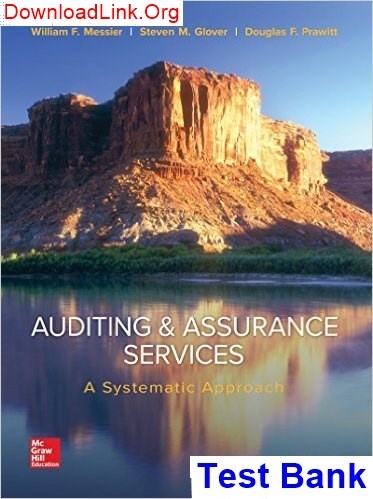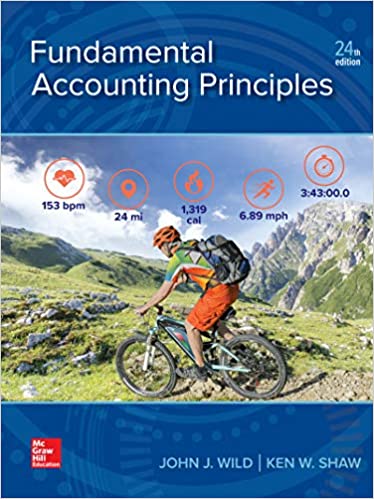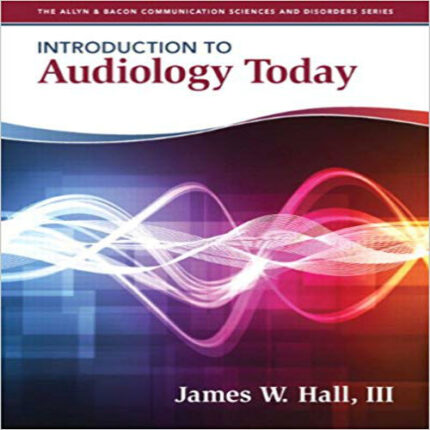Solution Manual for Auditing and Assurance Services 11th Edition by Messier
ISBN10: 1259969444, ISBN13: 9781259969447
Table of Contents
Part 1 Introduction to Assurance and Financial Statement Auditing
Chapter 1: An Introduction to Assurance and Financial Statement Auditing
Chapter 2: The Financial Statement Auditing Environment
Part 2 Audit Planning and Basic Auditing Concepts
Chapter 3: Audit Planning, Types of Audit Tests, and Materiality
Chapter 4: Risk Assessment
Chapter 5: Evidence and Documentation
Part 3 Understanding and Auditing Internal Control
Chapter 6: Internal Control in a Financial Statement Audit
Chapter 7: Auditing Internal Control over Financial Reporting
Part 4 Statistical and Nonstatistical Sampling Tools for Auditing
Chapter 8: Audit Sampling: An Overview and Application to Tests of Controls
Chapter 9: Audit Sampling: An Application to Substantive Tests of Account Balances
Part 5 Auditing Business Processes
Chapter 10: Auditing the Revenue Process
Chapter 11: Auditing the Purchasing Process
Chapter 12: Auditing the Human Resource Management Process
Chapter 13: Auditing the Inventory Management Process
Chapter 14: Auditing the Financing/Investing Process: Prepaid Expenses, Intangible Assets, and Property, Plant and Equipment
Chapter 15: Auditing the Financing/Investing Process: Long-Term Liabilities, Stockholders’ Equity, and Income Statement Accounts
Chapter 16: Auditing the Financing/Investing Process: Cash and Investments
Part 6 Completing the Audit and Reporting Responsibilities
Chapter 17: Completing the Audit Engagement
Chapter 18: Reports on Audited Financial Statements
Part 7 Professional Responsibilities
Chapter 19: Professional Conduct, Independence, and Quality Control
Chapter 20: Legal Liability
Part 8 Assurance, Attestation, and Internal Auditing Services
Chapter 21: Assurance, Attestation, and Internal Auditing Services
Appendix 1: Professional Judgment Framework – Understanding and Developing Professional Judgment in Auditing
Appendix 2: An introduction to Data Analytics
CHAPTER 1
AN INTRODUCTION TO ASSURANCE AND FINANCIAL STATEMENT AUDITING
Answers to Review Questions
1-1 The study of auditing is more conceptual in nature as compared to other accounting courses. Rather than focusing on learning the rules, techniques, and computations required to prepare financial statements, auditing emphasizes learning a framework of analytical and logical skills. This framework enables auditors to evaluate the relevance and reliability of the systems and processes responsible for financial information as well as the information itself. To be successful, students must learn the framework and then learn to use logic and common sense in applying auditing concepts to various circumstances and situations. Understanding auditing can improve the decision-making ability of consultants, business managers, and accountants by providing a framework for evaluating the usefulness and reliability of information—an important task in many different business contexts.
1-2 There is a demand for auditing in a free-market economy because the agency relationship between an absentee owner and a manager produces a natural conflict of interest due to the information asymmetry that exists between these two parties. As a result, the agent agrees to be monitored as part of his/her employment contract. Auditing appears to be a cost-effective form of monitoring.The empirical evidence suggests that auditing was demanded prior to government regulation. In 1926, before it was required by law, independent auditors audited 82 percent of the companies on the New York Stock Exchange. Additionally, many private companies and municipalities not subject to government regulations, such as the Securities Act of 1933 and Securities Exchange Act of 1934, also purchase various forms of auditing and assurance services. Many private companies seek out financial statement audits in order to secure financing for their operations. Companies preparing to go public also benefit from having an audit.
1-3 The agency relationship between an owner and manager produces a natural conflict of interest because of differences in the two parties’ goals and because of the information asymmetry that exists between them. That is, the manager likely has different goals than the owner, and generally has more information about the “true” financial position and results of operations of the entity than the absentee owner does. If both parties seek to maximize their own self-interest, the manager may not act in the best interest of the owner and may manipulate the information provided to the owner accordingly.
1-4 Independence is a bedrock principle for auditors. If an auditor is not independent of the client, users may lose confidence in the auditor’s ability to report objectively and truthfully on the financial statements, and the auditor’s work loses its value. From an agency perspective, if the principal (owner) knows that the auditor is not independent, the owner will not trust the auditor’s work. Thus, the agent will not hire the auditor because the auditor’s report will not be effective in reducing information risk from the perspective of the owner. Auditor independence is also a regulatory requirement.
1-5 Auditing (broadly defined) is a systematic process of (1) objectively obtaining and evaluating evidence regarding assertions about economic actions and events to ascertain the degree of correspondence between those assertions and established criteria and (2) communicating the results to interested users.
Attest services occur when a practitioner issues a report on subject matter, or an assertion about subject matter, that is the responsibility of another party.
Assurance services are independent professional services that improve the quality of information, or its context, for decision makers.
1-6 The phrase systematic process implies that there should be a well-planned, logical approach for conducting an audit that involves objectively obtaining and evaluating evidence. It requires organizing a plan for gathering evidence and documenting steps taken during the audit to evaluate the relevance and validity of the evidence.
1-7 Audit risk is defined as the risk that the auditor may unknowingly fail to appropriately modify his or her opinion on financial statements that are materially misstated (AS 1101). Materiality is defined as “the magnitude of an omission or misstatement of accounting information that, in the light of surrounding circumstances, makes it probable that the judgment of a reasonable person relying on the information would have been changed or influenced by the omission or misstatement” (FASB Statement of Financial Accounting Concepts No. 8, Chapter 3: Qualitative Characteristics of Useful Accounting Information, which is pending revision at the time of the writing of this book per the Board’s November 2017 decision to revert to a definition of materiality similar to the one found in superseded Concept No. 2).
The concept of materiality is reflected in the wording of the auditor’s standard audit report through the phrase “the financial statements present fairly in all material respects.” This is the manner in which the auditor communicates the notion of materiality to the users of the auditor’s report. The auditor’s standard report states that the audit provides only reasonable assurance that the financial statements do not contain material misstatements. The term “reasonable assurance” implies that there is some risk that a material misstatement could be present in the financial statements and the auditor will fail to detect it.
1-8 The major phases of the audit are:
- Client acceptance/continuance
- Preliminary engagement activities
- Plan the audit
- Consider and audit internal control
- Audit business processes and related accounts
- Complete the audit
- Evaluate results and issue audit report
1-9 Plan the audit: During this phase of the audit, the auditor uses knowledge about the client and any controls in place to plan the audit and perform preliminary analytical procedures. The outcome of the planning process is a written audit plan that sets forth the nature, extent, and timing of the audit procedures to be performed. The purpose of this phase is to plan an effective and efficient audit.
1-10 The auditor’s standard unqualified report for a public company client includes the following sections: (1) opinion on the financial statements, (2) basis for opinion, and (3) critical audit matters, as illustrated in this chapter.
1-11 The emergence of advanced audit technologies will help remove many of the tedious tasks that are usually performed by junior auditors. Thus, auditors of all positions and experience will be required to spend additional time reasoning through fundamental business, accounting, and auditing concepts. An auditors’ knowledge in these areas will enable them to provide greater benefit to clients by asking the right questions and identifying new, more effective ways to collect, analyze, and interpret results.In using audit data analytics, for example, auditors must understand the client and its industry, as well as the fundamentals of accounting and auditing, in order to ask the right questions in querying the data and in interpreting the results obtained.
1-12 Auditors frequently face situations where no standard audit procedure exists, such as the example from the text of verifying the inventory of cattle. Such circumstances require that the auditor exercise creativity and innovation when planning and administering audit procedures where little or no guidance or precedent exists. Every client is different, and applying auditing concepts in different situations requires logic and common sense, and frequently creativity and innovation.
Answers to Multiple-Choice Questions
| 1-13 | b | 1-19 | a | |
| 1-14 | b | 1-20 | d | |
| 1-15 | c | 1-21 | d | |
| 1-16 | c | 1-22 | d | |
| 1-17 | c | 1-23 | b | |
| 1-18 | c |





